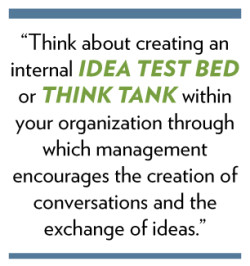Established firms need to learn how to encourage and utilize intrapreneurship so as to stay innovative, surpass client expectations and provide superior solutions to problems. It may not be a familiar term, but it will be an important tool in the hyper-accelerating climate for change in business and technology.
The reality is that not every employee is capable of adopting valuable entrepreneurial behaviour. For this reason, it is especially important that leaders in any organization are able to identify those employees who would be confident enough to actually blossom in this role. Strong leaders can encourage these employees by bouncing ideas around without the fear of failure – or worse, termination. While the understood possibility of failure is what holds back most organizations, leaders have to recognize that these perceived failures are often caused by pushing the envelope; they can quite often be a “learning stepping stone” capable of leading to a eureka! solution. Let’s face it: we often remember our failures or hiccups far more emotionally than our successes. For most entrepreneurial aspirants, the former are the challenges that fuel the passion to find innovative solutions.
 Think about creating an internal “idea test bed” or “think tank” within your organization through which management encourages the creation of conversations and the exchange of ideas. These groups can be developed with experienced senior team members, new hires and co-op or grad students to encourage and ignite passion for projects that are outside of their established routines. We have the luxury in today’s workforce of joining and benefiting from both a multi-generational talent pool and higher levels and broader scopes of education. While interrupting the status quo of established routines does come with its own challenges, many established companies have completely bought into “lean” operational systems and routines and, arguably, left the creative conversation at the door.
Think about creating an internal “idea test bed” or “think tank” within your organization through which management encourages the creation of conversations and the exchange of ideas. These groups can be developed with experienced senior team members, new hires and co-op or grad students to encourage and ignite passion for projects that are outside of their established routines. We have the luxury in today’s workforce of joining and benefiting from both a multi-generational talent pool and higher levels and broader scopes of education. While interrupting the status quo of established routines does come with its own challenges, many established companies have completely bought into “lean” operational systems and routines and, arguably, left the creative conversation at the door.
I truly believe that the new talent pool of graduates will demand greater entrepreneurial spirit, and, if it is not available, businesses will experience higher levels of talent turnover. Over time, this will prove costly in terms of human resources, training and productivity gaps.
Again, let’s face it: to remain industry leaders, businesses can no longer afford to ignore the need to stimulate ideas and concepts. We now compete and prosper globally – not regionally – in most industries; failing to foster the ability to adapt and innovate will be hugely expensive. And who knows, the other employees in your organization may be inspired and impassioned just by watching the party from the outside!
Karen Behune Plunkett is Principal at PinPoint Strategic Direction, an advisory and strategic consulting firm, encouraging entrepreneurs, businesses and organizations to effectively identify goals and priorities. www.pinpointsd.com




